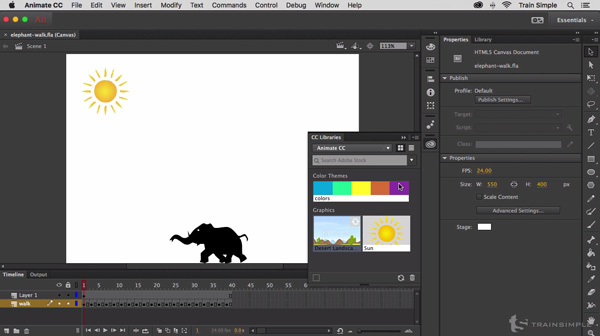
If not, sign up now and get the CS6 Superguide for free.
#Image to texture adobe animate cc 2019 free#
If you’re on our list, you will receive it free by email as soon as it’s available.
#Image to texture adobe animate cc 2019 pdf#
Add a comment and let me know what you think and let me know what types of tutorials you will like to see here at PhotoshopCAFE!Īll the CS6 information and more is available as a PDF magazine called the CS6 Superguide. (Make sure you hit render when you can go away and do something else). Now, it will take hours to render, but the quality will be great. This time, change the 3D quality toRay Traced Final. If you like the video, export to video again. This will render somewhat crappy, but it’s faster and lets you see what the final will look like. Select raytraced draft to test the animation. In the bottom, Under Render Options, you will see 3D quality. Time to Render the animation to video Step 7 Press play in the timeline to see the cube rotate. Open properties and look for the Y axis rotationĬhange the y-rotation, you should see your cube spin in the main window.Ī new keyframe will automatically be added to the timeline. Make sure you have selected the 3D panel and choose the materials tab. Move the playhead to the end of the timeline. Move the playhead to frame 1 if it isn’t already there.įind the cube under material. Open the timeline and click the Create Frame Animation Option Ok, once you have made the cube following these written instructions, or the video at the top, here is how you can animate it! Step 1 Photoshop will create a higher quality purview when you render the 3D model and Lighting, this can take a while. Press Cmd+Shift+Option+R (Ctrl+Shift+Alt+R -windows) to render.

To make the shadow softer, Change the Softness amount in the Properties panel.Īnd here is your Final cube. You will see a Lighting widget (a ball with a stem)Ĭlick and drag with this to set the lighting direction. On the 3D panel, choose the Lightbulb icon to switch to the Lighting options. What we need to do is get the lighting all set up to make the cube appear how we want.


We now have images mapped to all the visible faces. Click on Right_Material form the 3D panel.Ĭhoose Diffuse from the 3D panel and select photograph We are adding another photo to the right face now. The animation above shows the difference in a detail area zoomed. Enhance Details works well on both Bayer (Canon, Nikon, Sony, etc.) and X-Trans (Fujifilm) raw mosaic files. To add images to each surface, you are repeating the steps above for each face. Enhance Details uses machine learningan extensively trained convolutional neural network (CNN)to provide state-of-the-art quality for the images that really matter. Navigate and select the photo to use from your computer Click on the 3rd button across, this is the materials panel where all the textures (images) are controlled from.Ĭhoose the Properties panel, this is where you can use an image for the texture.Ĭlick on the icon to the right of the Diffuse Your photo on the front face of the cube, cool!Ĭhoose the 3D panel. You will see some tools at the top, grab the tumble tool and drag on the screen to rotate the cube You will see an option to with to the 3D workspace, accept this option 3. 2.Ĭhoose 3D>New Mesh From Layer>Mesh Preset>Cube In this case, I’m using my aerial Tiny Planet photos.


 0 kommentar(er)
0 kommentar(er)
